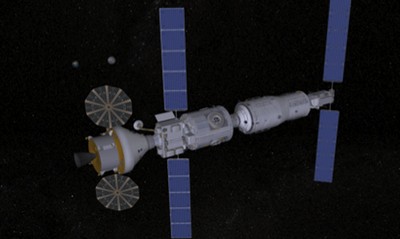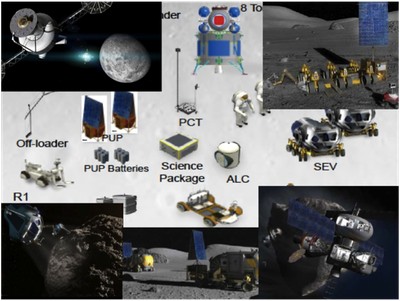If you set out to go to Mars, go to Mars!by Harley Thronson
|
| Since the end of the Apollo program almost a half-century ago, there has been almost no proposed major concept or architecture that has been received by the human spaceflight communities with anything less than polite applause. |
If sustained human travel to Mars within, say, two decades is unambiguously the goal for the international human spaceflight communities, current culture and practices are inhospitable to success. Almost a half-century after Apollo 11, these communities remain inappropriately welcoming to a vast range of options, architectures, and goals for human space flight beyond low Earth orbit (LEO), most of which cannot take place and will have to be winnowed.
Inspiration Mars, as one example, is an alternative model to the common practices of the general human space flight communities: an elemental and focused enterprise that can succeed if the project expends resources only on that which is absolutely necessary.
Many of the following observations about Mars exploration apply equally if human missions to the lunar surface are instead the unambiguous goals for human spaceflight, bearing in mind the recent warning by Dr. Steven Squyres that a lunar surface campaign probably dooms human missions to Mars for the foreseeable future.
A community that cannot say “no”
Since the end of the Apollo program almost a half-century ago, there has been almost no proposed major concept or architecture that has been received by the human spaceflight communities with anything less than polite applause. Industrial-level mining of the Moon and asteroids, colonization of Mars and the Moon, fusion propulsion, and space “elevators” and “cyclers” of various kinds may one day be necessary. However, very few seem conceivably affordable, achievable, or desirable for a program focused on a plausible mission to Mars within the lifetime of readers of this essay. It is collegial to tolerate presentations about far-future concepts. At the same time, such concepts should be recognized as distractions and unrelated to the difficult challenges of early Mars missions. And very soon, if humans are to travel to Mars in the reasonably near future, a significant number of proposed technology capabilities for future human exploration will have to be recognized as irrelevant, and our communities will have to decline to pursue them further.
Human spaceflight cannot go from A to C without serious consideration of B
Since well before the Apollo program, extensive resources have been expended on more or (often) less plausible human missions to Mars, including extensive exploration of its surface. In addition, the ISS is underway toward developing key capabilities necessary in advance of a long-duration mission to Mars. That is, taken together both the first “stepping stone” as well as the final destination have been assessed for decades in significant depth.
| Humanity’s second—or third or fourth—mission to Mars will never happen unless there is a first one. |
What is missing seems to be serious consideration of realistic and affordable intermediate or “bridge” missions that explicitly build upon the ISS and focus on enabling subsequent travel to Mars. Although proposed missions to the Moon, for example, or libration points often claim preparation for travel to Mars, almost invariably this capability is listed among the last of a number of other goals. I discuss elsewhere how the Gemini “stepping stone” between the Mercury and Apollo Programs should be considered as a model for building upon the ISS in preparing for a Mars voyage (see “NASA’s Gemini Program: a “stepping stone” to Mars?”, The Space Review, March 25, 2013).
 A Boeing/Roscosmos concept to modify existing or already designed ISS modules as a free-space “stepping stone” beyond low-Earth orbit. |
There are two unambiguous exceptions to this point: the Decadal Planning Team (DPT) and the Boeing/Roscosmos concept shown in the figure above. The DPT, an activity jointly supported by both NASA and the Office of Management and Budget and now almost a decade and a half in the past, assessed in some depth development of a series of “stepping stone” missions, each building on a predecessor and focused specifically on a longer-term goal. The current Boeing/Roskosmos concept would use available ISS modules and designs to demonstrate key capabilities beyond ISS specifically to enable a future Mars mission. Of course, with both the DPT and Boeing/Roscosmos architectures other goals could be achieved while preparing for a Mars mission. However, these other activities would be decidedly secondary and would be sacrificed if they distracted from the primary mission.
It would be speculation as to why detailed concepts developed by the exploration communities to build upon ISS and specifically enable a subsequent Mars mission are virtually unknown. However, the lack of seriousness of community planning for Mars exploration can be judged by the degree to which precursor or “bridge” concepts building on ISS successes in advance of voyages to Mars are investigated; that is, very little. (In an earlier version of this essay, colleagues pointed out that Inspiration Mars could be considered as a “bridge” or demonstration mission in advance of a later, more elaborate mission. Indeed, that could be the case to the degree that this inventive project demonstrates key capabilities that can be subsequently applicable.)
The greatest challenge to the first mission to Mars are all those that follow
In defeating the Austrian forces defending Vienna in 1809, Napoleon concentrated on the immediate goals and threats. Apparently, the emperor gave little consideration to the subsequent governing of the Austrian Empire while outcome of his military campaign was in doubt. In the awkward phraseology of the 21st Century, Napoleon was prioritizing.
A useful tautology: humanity’s second—or third or fourth—mission to Mars will never happen unless there is a first one. Vastly more resources have been expended on concept design and technologies that appear to be necessary for sustained Martian exploration, with comparatively fewer specifically on the most essential mission, the first one. Just as with all programs of human exploration, the first Mars expedition will be very—very!—different from every one that follows. It will have to be more limited, more focused, and necessarily affordable from the start. More will be learned on a first mission, no matter how limited it is some respects, than on any subsequent one. However, in the current, uncritical, and comfortable environment for proliferating concepts for human exploration beyond LEO, there seems to be only modest interest in the difficult process of in-depth, critically reviewed engineering designs for the first Mars mission.
Perhaps Inspiration Mars will be that first mission to Mars: pared down to essential capabilities and focused on early achievement. It is also notably uninvolved in ancillary goals for human spaceflight unrelated to early travel to Mars: industrialization of the Moon and asteroids, libration-point observatories and refueling stations, and colonization of Mars do not figure into this team’s mission design and technology priorities. But unequivocally, if successful, Inspiration Mars will reveal more about deep space, beyond LEO human exploration than the decades of design studies and laboratory demonstrations completed since the end of the Apollo Program.
| The missions that must fly should never be endangered by the missions that we wish we could fly. This is especially true with the earliest human missions to Mars. |
Furthermore, it is arguable that industrial-level development of lunar resources to support sustained human Mars exploration should follow, not precede, the first few successful human missions to Mars. Get to Mars with pioneering humans, demonstrate that it is possible and desirable, and, once successful, follow with lunar resource development to make subsequent Mars missions also affordable. That is, “Mars first, then the Moon,” which is consistent with historical exploration: in the 19th Century, the American West was explored for decades by trappers, frontiersmen, and occasional minimal expeditions sent by the central government. Only later was the elaborate national infrastructure established to support sustained development of the West. In contrast, widely popular “Moon first, then Mars” architectures are a reverse of the historical experience of human exploration on Earth.
Suggestions to disrupt the current stasis
The current culture and practices of the international industry, academic, and government aerospace communities is inhospitable toward a successful human Mars mission within a couple decades.
Possible solutions exist:
- Clever, but implausible, unaffordable, or distracting concepts and technologies should be recognized as increasingly out of place in a budget-constrained environment as time passes and important enabling technology investment opportunities are missed.
- With ISS as the first key “stepping stone” into space, essential subsequent capabilities should be identified and developed, Gemini program-like, in advance of a Mars mission. Perhaps there are none other than those that are underway on ISS. Or, perhaps the design for the mission to Mars can itself be used as a precursor demonstration, becoming increasingly capable in vicinity of the Earth before its first mission beyond the Earth-Moon system.
- The missions that must fly should never be endangered by the missions that we wish we could fly. This is especially true with the earliest human missions to Mars. With limited resources—in both time and funding—emphasis must be on developing only those key capabilities that are essential to early success. The single defining characteristic of a sustainable program of human Mars exploration is that it is affordable.
